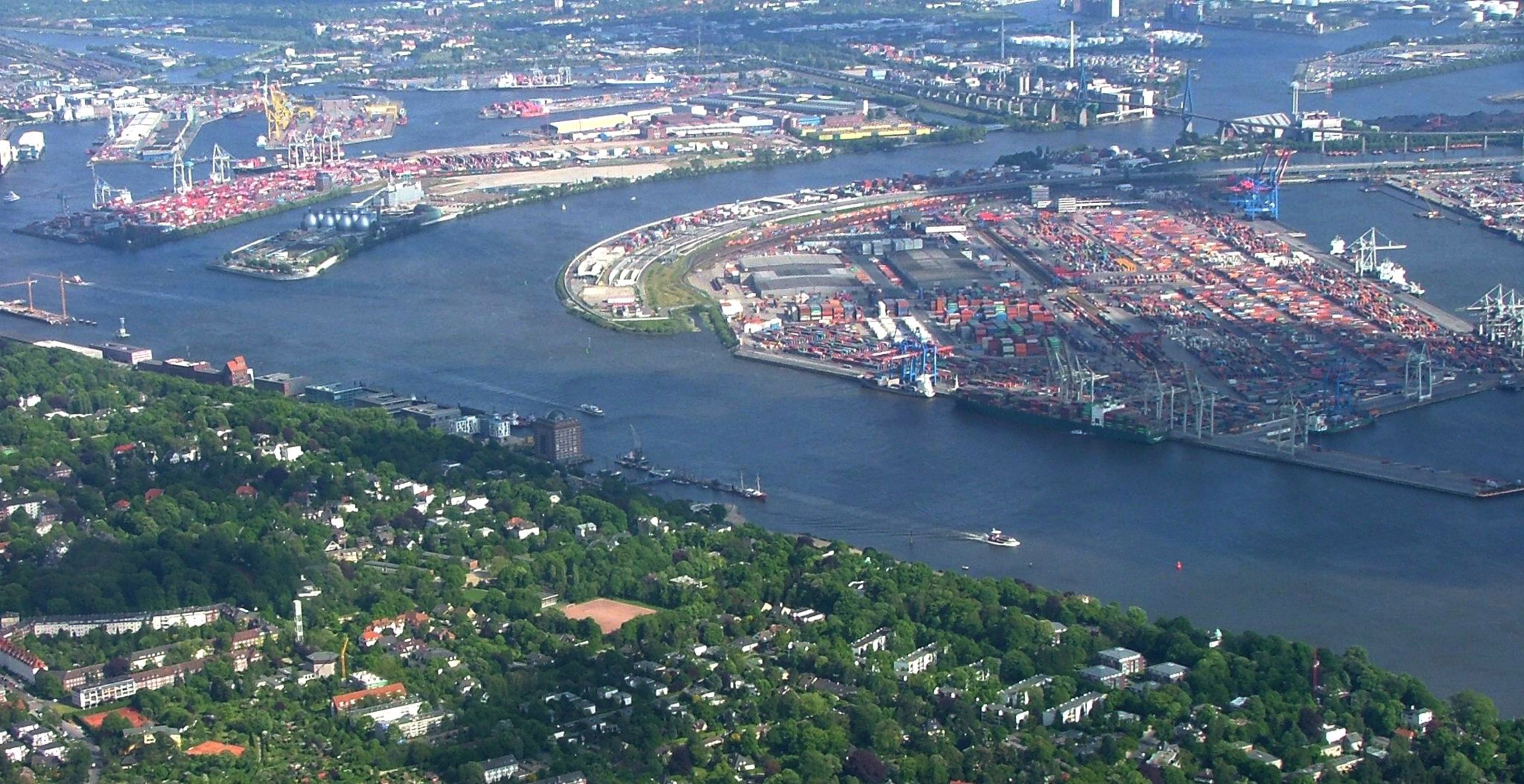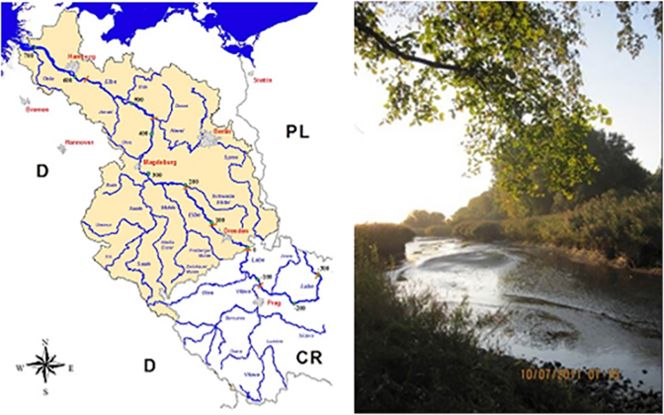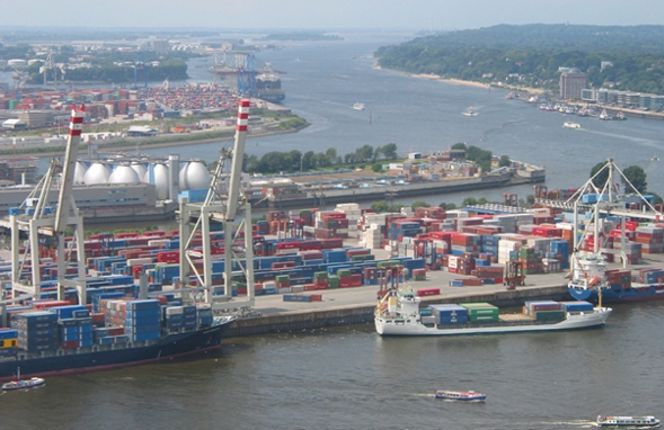- NGI /
- Projects /
- Case studies /
- Elbe North sea Estuary
Elbe North sea Estuary
The Elbe River is one of the major rivers in Western Europe. From its spring in the Giant Mountains (Czech Republic) to its mouth at the North Sea near Cuxhaven (Germany) it covers a distance of 1,091 kilometres.

The Elbe catchment area of 148,268 km2 is roughly divided between the Czech Republic (one third) and the Federal Republic of Germany (two thirds). Small areas belong to Poland and Austria. Along its way the catchment drains some of north and central Europe¿s major cities including Prague, Dresden, Berlin and Hamburg. The only weir in the German part of the major river is in Geesthacht at river km 585,9. It marks the beginning of the tidally influenced "Lower Elbe" which - at first - only contains freshwater, even though it is tidally influenced. As a consequence some of the rare freshwater mudflats are located along this stretch.

Left: Elbe-catchment (Graph: BfG, from Heise et al. 2008), Right: The nature reserve Heuckenlock - a rare freshwater mudflat (foto: Heise)
Salinity starts to increase about 70 km further downstream, after the Elbe has passed Hamburg. According to EU-definition, the term "estuary" would apply only to a part of the tidal Elbe, from the mouth of the river to the upstream border of the brackish area. From an ecological perspective however, the brackish and the freshwater part of the Tidal Elbe cannot be separated in the discussion about habitats and species diversity. Hence, the whole area downstream of Geesthacht is regarded as "Elbe estuary" when addressing the Water Framework Directive.
The estuary is very diverse and contains nature reserves as well large areas of fruit, vegetable and flower farming, urban areas and as a major city Hamburg with 1.7 Mio inhabitants. But the characteristics of the lower Elbe have been mostly shaped by its economic function: as a shipping water way leading up to the second largest port of Europe, the port of Hamburg. Since its formation in the 12th century it continuously gained importance. In the 19th century, the still relative natural river could not keep up anymore with the increasing demands in traffic and size of the ships. At that time, the Elbe was still relatively shallow with a depth of about 4 m and a lot of small islands formed by the delta close to Hamburg. Since the early 19th century the Elbe has been deepened seven times and it now allows ships with a depth of 13.5 meters to reach Hamburg.

The Port of Hamburg (Foto: M. Bergemann)
Directly or indirectly, 155.000 people were employed in connection with harbour activities in 2010 which adds up to more than 10 % of all jobs in Hamburg. The tax revenue from harbour activities amounted to about 750 mio Euro in 2010 ( see www.westerweiterung.de).
Immigration, economic growth and an employment increase at the beginning of the 90s led to the realization, that increasing economical demands and challenges could not be tackled by one Federal State alone. Hamburg agreed with its adjacent neighbours, Lower Saxony and Schleswig-Holstein, to increase cooperation in the Metropolitan Region, to create a common job market and a unified economical region. The "Metropolregion Hamburg" now comprises 800 cities and municipalities, and 4.2 mio inhabitants.
The ecological situation of the Elbe Estuary is influenced in terms of chemical quality by the dissolved or - more important - particle bound contaminants that are mostly transported from upstream legacies of the past in the Czech Republic and former GDR area of the downstream. It is also - even though to a lesser degree - influenced by local industrial emissions. The Elbe was once considered to be among the rivers in Europe with the highest diversity and amount of fish. Pollution of the river together with the weir in Geesthacht caused a collapse and extinctions of many fish species. Improvement of water quality since the 1980s and construction of a fish pass at the weir have led to a recovery in fish abundance and now more than 100 species can be found again in the estuary.
Nowadays, however the challenge comes from long-term modifications of the river morphology like deepening of the stream, building of dikes and river embankments which have led to extensive changes in the water current velocity, oxygen content, transport and sedimentation patterns of suspended material and tidal ranges.

Left: Neufelder Watt 2009 (Foto: Heise), Right: Flood 1962 in Wilhelmsburg, Hamburg (Foto: Gerhard Pietsch)
Public perception of the tidal estuary reflects the many aspects of that region. The port of Hamburg and the Elbe River are probably among the major tourist attractions and facilitate tourism due to the visiting cruise ships. Water quality is not perceived as a problem and the official Elbe-Bathing Day on July 17th, 2005 was regarded a success. Towards the mouth of the river, the Wadden Sea, which was added to the UNESCO World Heritage List in 2009, draws a lot of visitors to the region who wander the area during low tide.
But living with a big stream also has its challenges. After a flood in 1962 which costed the lifes of 340 people, citizens that live near the river are still very sensitive to the risk of flooding. Different opinions on whether plans of the Hamburg Port Authority to deepen the Elbe in and downstream of Hamburg could decrease stability of dikes and may increase flood risks fostered heated debates which soon became political: The Elbe downstream of Hamburg belongs to the Federal States Lower Saxony and Schleswig-Holstein. Additional uncertainty among people evolves from the discussion of climate change related issues, especially sea level rise, which may worsen the effects of floods in some areas of the tidal river, as well as cause problems for agriculture and nature preservation. Consequences and potential measures of climate change on the Elbe estuary are currently investigated by a number of research projects such as Klimzug-Nord (www.klimzug-nord.de), Kliwas (www.kliwas.de), DiPol (www.interreg-dipol.de) and Sawa (www.sawa-project.eu).
Contacts:
- Susanne Heise, Sub-project Manager, Susanne.Heise@haw-hamburg.de
- Ivonne Stresius, ivonne.stresius@haw-hamburg.de